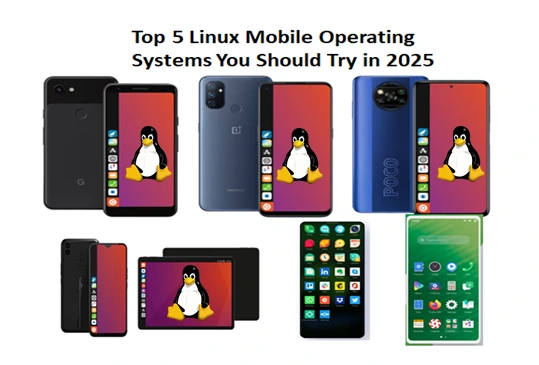In a world dominated by iOS and Android, many of us yearn for something different—a platform that aligns with our values of freedom, privacy, and customization. Enter Linux mobile operating systems. These alternatives aren’t just for the tech-savvy; they’re for anyone who wants more control over their devices and data. From breathing new life into old hardware to offering cutting-edge features, Linux-based mobile OSes are rewriting the rules of mobile computing. If you’re curious about breaking free from the mainstream, here are the top 5 Linux mobile operating systems you should explore in 2025.
Top 5 Linux Mobile Operating Systems You Should Try in 2025
1. PostmarketOS
PostmarketOS (pmOS) is an open-source operating system designed to extend the lifespan of smartphones by replacing their original firmware with a Linux-based system. Based on Alpine Linux, pmOS emphasizes modularity, security, and user control, aiming to provide a sustainable alternative to traditional mobile operating systems.

Key Features of PostmarketOS:
- Device Support: As of June 2024, pmOS can boot on over 250 devices, including smartphones and tablets that originally ran Android, as well as some Linux-based Nokia smartphones like the N900 and N9. However, the level of functionality varies across devices; some may only boot, while others have more comprehensive support.
- User Interfaces: pmOS supports various user interfaces, allowing users to choose their preferred environment. Available options include Plasma Mobile, Phosh, Sway, and Sxmo, catering to different user preferences and hardware capabilities.
- Mainline Linux Kernel: The project strives to support the mainline Linux kernel on all devices, moving away from outdated, device-specific kernels. This approach enhances security and maintainability by aligning with the latest kernel developments.
- Development Tools: pmOS offers tools like pmbootstrap to facilitate development and cross-compilation, and osk-sdl, a virtual keyboard for password decryption during startup, enhancing the development experience and user security.
Smartphones Featuring PostmarketOS:
While pmOS is primarily a community-driven project intended for installation on existing devices, it has been featured on certain smartphones:
- PinePhone: Developed by Pine64, the PinePhone is a Linux-based smartphone designed with hardware kill switches and modularity in mind. In 2020, Pine64 released a “Community Edition” of the PinePhone that shipped with postmarketOS pre-installed, providing users with a device that aligns with the principles of open-source software and user control.
- Device Compatibility: Beyond the PinePhone, pmOS can be installed on a wide range of devices. The project maintains a comprehensive list of supported devices, detailing the functionality and support level for each, enabling users to repurpose older hardware with a modern, secure operating system.
Current Status and Considerations:
As of January 2025, postmarketOS is an active project with ongoing development. While it offers a promising alternative for extending the life of smartphones, users should be aware that support varies by device, and some features may be incomplete or under development. It’s advisable to consult the official postmarketOS device wiki to assess the compatibility and functionality of specific devices before installation.
In summary, postmarketOS represents a significant effort in the mobile Linux ecosystem, providing users with the tools to regain control over their devices and promote sustainability through extended hardware lifecycles.
2. Ubuntu Touch
Ubuntu Touch is an open-source mobile operating system based on Ubuntu, designed for smartphones and tablets. Initially developed by Canonical Ltd. in 2013, the project transitioned to the UBports Foundation in 2017, which continues its development and support.
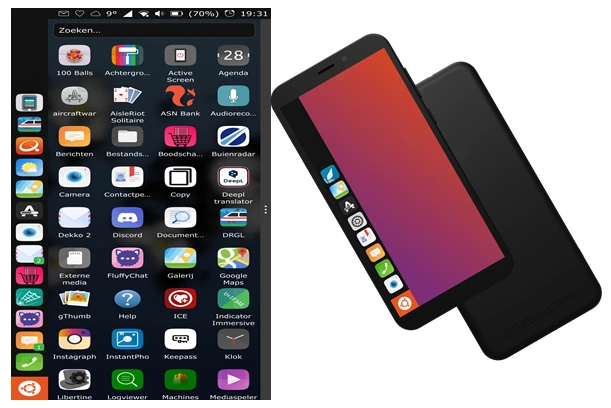
Key Features of Ubuntu Touch:
- User Interface: Ubuntu Touch offers a gesture-driven interface, allowing users to navigate seamlessly without physical buttons. Swipes from the edges provide access to app launchers, multitasking views, and application-specific tools.
- Convergence: A standout feature is its convergence capability, enabling the device to function as a desktop computer when connected to a larger screen. This provides a unified experience across different device types.
- Open Source Ecosystem: Emphasizing user privacy and freedom, Ubuntu Touch is built entirely on open-source software, allowing for community-driven development and transparency.
Smartphones Compatible with Ubuntu Touch:
Ubuntu Touch can be installed on various devices, especially those originally running Android. The UBports Installer facilitates this process, making it accessible even to users with minimal technical expertise.
Here are some notable devices compatible with Ubuntu Touch:
PinePhone
An ARM-based smartphone developed by Pine64, designed to run mainline Linux operating systems like Ubuntu Touch. It offers hardware kill switches for privacy and is known for its developer-friendly nature.
PinePhone Pro
An upgraded version of the PinePhone, featuring improved hardware specifications for better performance with Linux-based operating systems.
PineTab
A Linux-powered tablet from Pine64, compatible with Ubuntu Touch, offering an open-source alternative to mainstream tablets.
PineTab 2
The successor to the PineTab, featuring enhanced hardware and design, aimed at providing a better user experience with Linux-based operating systems.
Volla Phone
A smartphone that comes pre-installed with Ubuntu Touch, focusing on user privacy and a simplified user experience.
Google Pixel 3a
The Google Pixel 3a is a versatile device for users interested in exploring Linux mobile operating systems. Both Ubuntu Touch and CalyxOS provide unique experiences, catering to different user preferences and needs.
Recent Developments:
In 2023, UBports released Ubuntu Touch 20.04 OTA-3, bringing stability improvements, new keyboard layouts, and enhanced support for devices like the PinePhone, PinePhone Pro, PineTab, and PineTab 2.
Ubuntu Touch presents a compelling alternative for users seeking an open-source, privacy-focused mobile operating system. With its unique convergence feature and a growing list of compatible devices, it offers a versatile and community-driven mobile experience.
3. Sailfish OS
Sailfish OS is a Linux-based mobile operating system developed by the Finnish company Jolla. Emerging from Nokia’s discontinued MeeGo project, Sailfish OS combines open-source components with proprietary elements to deliver a unique user experience. The operating system is renowned for its robust multitasking capabilities, gesture-based interface, and compatibility with Android applications.
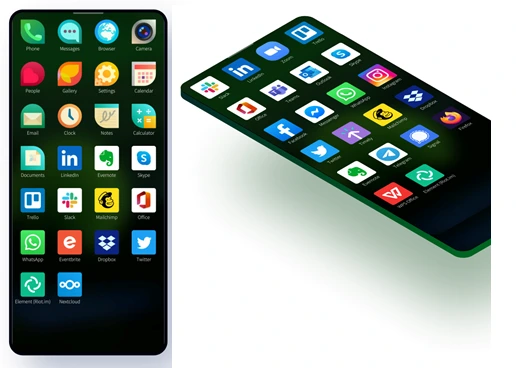
Key Features of Sailfish OS:
- Multitasking: Sailfish OS allows users to run multiple applications simultaneously, facilitating seamless switching and efficient task management.
- Gesture-Based Navigation: The intuitive swipe gestures enable users to navigate the interface effortlessly, enhancing the overall user experience.
- Android App Compatibility: Through a proprietary compatibility layer, Sailfish OS supports the installation and use of many Android applications, broadening its app ecosystem.
- Customization: The operating system offers extensive personalization options, allowing users to tailor the interface to their preferences.
Smartphones Running Sailfish OS:
While Sailfish OS is not as widely adopted as Android or iOS, it has been implemented on several devices:
- Jolla Phone (2013): The inaugural device from Jolla, featuring a 4.5-inch display, dual-core processor, and 8 MP camera.
- Jolla Tablet (2015): A tablet device equipped with a 7.85-inch display, designed to showcase the capabilities of Sailfish OS.
- Jolla C (2016): A limited-edition smartphone aimed at developers and community members, featuring a 5-inch display and improved hardware specifications.
- Sailfish X Program: Jolla offers official support for installing Sailfish OS on select Sony Xperia devices, including the Xperia X, Xperia XA2, Xperia 10, Xperia 10 II, and Xperia 10 III. This initiative allows users to purchase a license and install Sailfish OS on compatible devices.
As of January 2025, there are no new smartphones shipping with Sailfish OS pre-installed. However, the Sailfish X program continues to provide enthusiasts with the opportunity to experience Sailfish OS on supported Sony Xperia devices. Additionally, the Sailfish community actively develops unofficial ports for various devices, expanding the reach of the operating system.
For more information on Sailfish OS and device compatibility, visit the official website:
4. Mobian
Mobian is an open-source project that adapts the Debian GNU/Linux distribution for mobile devices, including smartphones and tablets. Launched in 2020, Mobian integrates the Phosh (Phone Shell) graphical interface, developed by Purism, to provide a user-friendly experience on touchscreens.
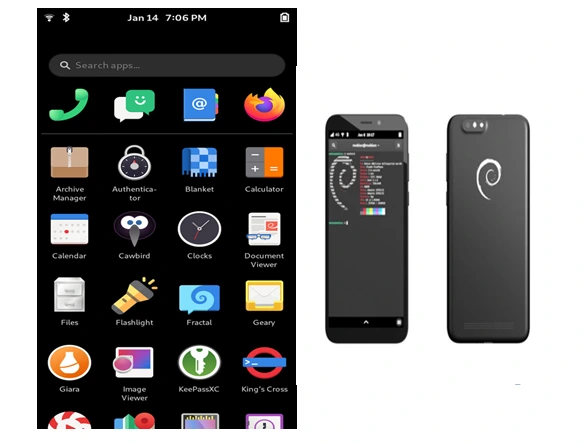
Supported Devices
Mobian is compatible with several devices, particularly those designed with Linux compatibility in mind. Notable supported devices include:
- PinePhone and PinePhone Pro: Developed by Pine64, these smartphones are built to support various Linux-based operating systems. In January 2021, the PinePhone Mobian Community Edition was released, featuring Mobian pre-installed and contributing a portion of sales to Mobian’s development.
- PineTab: A tablet from Pine64 that supports Mobian, offering users a Linux-based tablet experience.
- Librem 5: Produced by Purism, this smartphone emphasizes security and privacy, running on free and open-source software, including Mobian.
- OnePlus 6/6T and Pocophone F1: Originally Android devices, these smartphones can run Mobian through community-driven efforts to expand device compatibility.
Software Stack
Mobian utilizes the Phosh graphical interface, based on GTK, to deliver a cohesive user experience on mobile devices. While users can install a wide range of Debian applications, not all are optimized for small touchscreens. The Mobian project maintains a curated list of applications that function well on mobile devices, many of which are GNOME-based.
Development and Community
The Mobian project is maintained by two teams: Mobian and DebianOnMobile. DebianOnMobile focuses on upstream components, while the Mobian team manages downstream packages that may contain non-upstreamable patches or are not yet ready for inclusion in Debian.
Getting Mobian
Mobian provides images for various devices, with installation procedures varying depending on the original operating system of the device. Users interested in installing Mobian can find detailed instructions and download links on the official Mobian website.
5. PureOS
PureOS is a Linux-based operating system developed by Purism, emphasizing privacy, security, and user freedom. Derived from Debian, it exclusively incorporates free software that adheres to the Debian Free Software Guidelines. The Free Software Foundation has endorsed PureOS as a freedom-respecting operating system.
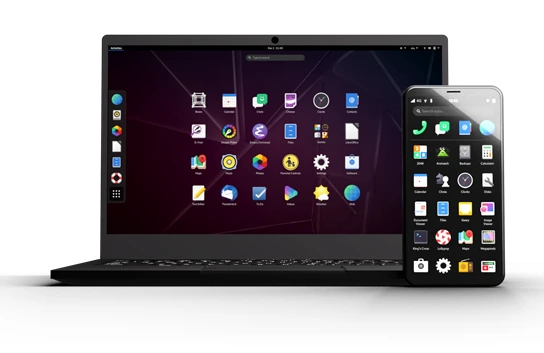
Overview
PureOS, developed by Purism, powers the Librem 5 smartphone and is designed with a strong focus on privacy and security. It’s endorsed by the Free Software Foundation for its commitment to free and open-source principles.
Key Features:
- Security-Centric: Built-in encryption and privacy protection.
- Freedom Respecting: 100% free software without proprietary dependencies.
- Adaptive UI: Scales seamlessly between mobile and desktop environments.
- Hardware Integration: Optimized for the Librem 5, but adaptable to other devices.
Designed for both desktop and mobile environments, PureOS utilizes the GNOME desktop environment by default, with KDE Plasma as an alternative. Its convergence feature allows seamless operation across various devices, including laptops and smartphones. The operating system comes with pre-installed applications tailored for essential tasks, such as GNOME Web for browsing and DuckDuckGo as the default search engine.
A notable smartphone that ships with PureOS is the Librem 5, developed by Purism. The Librem 5 is engineered with a strong emphasis on security and privacy, featuring hardware kill switches for the camera, microphone, Wi-Fi/Bluetooth, and baseband processor. This design ensures that users have physical control over these components, enhancing overall security. The device also separates the CPU from the baseband processor, further isolating critical functions.
The Librem 5 utilizes a mobile interface called Phosh (phone shell), developed by Purism. Phosh is based on Wayland, wlroots, GTK, and GNOME technologies, providing a touch-friendly user experience. This interface is designed to integrate closely with the desktop Linux software stack, facilitating long-term maintenance and compatibility with existing desktop Linux distributions.
In addition to the Librem 5, other devices have explored compatibility with PureOS. For instance, the Necuno NC_1 is a mobile device that can run various open-source operating systems, including PureOS. However, it’s important to note that the Necuno NC_1 lacks a cellular modem, limiting its functionality as a traditional smartphone.
PureOS supports fundamental smartphone functions, including phone calls, messaging, web browsing, and clock features. Its commitment to user privacy and security makes it a compelling choice for individuals seeking an open-source mobile operating system that prioritizes freedom and transparency.
Ideal For:
Privacy-conscious users who prioritize free software and secure communication.
In summary, PureOS stands out as a privacy-focused, secure, and user-friendly Linux-based operating system. Its application in devices like the Librem 5 showcases its versatility and commitment to user freedom in the mobile computing landscape.
Comparison Table: Top Linux Mobile Operating Systems
| Operating System | Key Features | Ideal For |
|---|---|---|
| PostmarketOS | Supports over 300 devices | Tech-savvy users repurposing old devices |
| Multiple desktop environments (Phosh, Plasma Mobile, Sxmo) | ||
| Privacy-centric and free from proprietary services | ||
| Long-term updates for a 10-year lifespan | ||
| Ubuntu Touch | Convergence feature for desktop-like functionality | Users needing versatility for work and entertainment |
| Wide range of community-driven apps via Open Store | ||
| Intuitive gestures and navigation | ||
| No intrusive data collection | ||
| Sailfish OS | Android app compatibility | Users wanting sleek UI with Android app support |
| Gesture-based navigation | ||
| Real-time multitasking on the home screen | ||
| Data encryption and privacy tools | ||
| Mobian | Debian ecosystem with thousands of packages | Developers and Linux enthusiasts |
| Phosh desktop environment | ||
| Privacy-oriented and control over data | ||
| Optimized for PinePhone and Linux-friendly devices | ||
| PureOS | Built-in encryption and privacy protection | Privacy-conscious users |
| 100% free software without proprietary dependencies | ||
| Adaptive UI for mobile and desktop | ||
| Optimized for Librem 5 hardware |
Why Choose Linux Mobile Operating Systems?
Linux-based mobile operating systems empower users with more control, enhanced privacy, and the flexibility to customize their experience. Unlike proprietary systems, these platforms are community-driven and continually evolving to meet user needs.
Conclusion
As we navigate the ever-changing landscape of mobile technology, Linux-based operating systems offer a refreshing alternative to the status quo. They prioritize what matters most: user freedom, data privacy, and device longevity. Whether you’re looking to revive an aging device, explore cutting-edge software, or embrace a more open digital ecosystem, these five Linux mobile operating systems are well worth your attention in 2025. The future is open—are you ready to take the leap?
Disclaimer
The information provided in this article is for general informational purposes only. While every effort has been made to ensure the accuracy and reliability of the content, the rapidly evolving nature of technology means that features, compatibility, and support for the mentioned operating systems may change. Readers are encouraged to visit the official websites of the respective operating systems for the latest updates and detailed information. The author and publisher are not responsible for any discrepancies, damages, or issues arising from the use of the mentioned operating systems.
Also Read
Kali Linux Vs. Competing Penetration Testing Distributions: Which Is Best for You in 2025?

